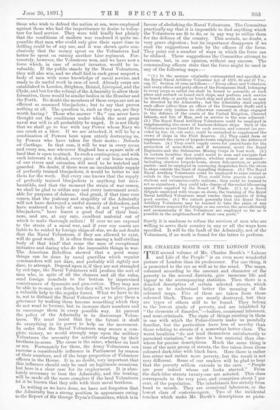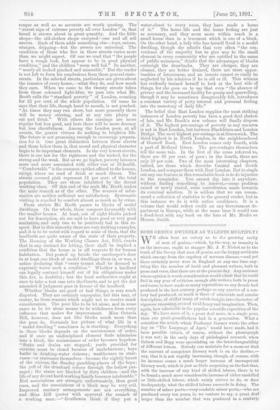MR. CHARLES BOOTH ON THE LONDON POOR. T HE second volume
of Mr. Charles Booth's "Labour and Life of the People" is an even more wonderful picture of London than its predecessor. For one thing, it is presented to the eye as well as to the mind. The maps, coloured according to the amount and character of the poverty in the several districts, give immense life and vigour to the accompanying statistics. Then there is a detailed description of certain selected streets, which helps us to understand better the meaning of the coloured maps. Five of these are taken from those coloured black. These are mostly destroyed, but they are types of others still to be found. They belong to the lowest grade of poverty, and are inhabited by "the elements of disorder,"—loafers, occasional labourers, and semi-criminals. The state of things existing in them is one with which the Police-Courts make us painfully familiar, but the particulars have less of novelty than those relating to streets of a somewhat better class. The worst localities "do not lend themselves satisfactorily to parochial visitation," so there is less material than else- where for precise descriptions. Much the same thing is true of the next group of streets, the five taken from those coloured dark-blue with black lines. Here there is rather less crime and. rather more poverty, but the result is not very different. Some of our readers will be glad to hear that the poverty seldom extends to the cats. "People are poor indeed whose cat looks starved." From the dark-blue streets twenty-one are selected. This class corresponds to the very poor, and comprises about 7 per cent, of the population. The inhabitants live strictly from hand to mouth. They are occasional labourers, or the lowest class of costermongers. Two of the incidental touches which make Mr. Booth's descriptions so pieta- resque as well as so accurate are worth quoting. The "surest sign of extreme poverty all over London" is, that bread is strewn about in great quantity. And the little shops—the old-clothes shops excepted—one and all sell sweets. Each of them adds something else—toys, onions, oranges, dripping—but the sweets are universal. The condition of those who live in these streets varies more than we might expect. Of one we read that "the people have a rough look, but appear to be in good physical condition," and the children "seem well fed." In another, "nearly all looked pinched and miserable." But the reader is not left to form his conclusions from these general state- ments. In the selected streets, particulars are given about the inmates of every house,—what they do, and how much they earn. When we come to the twenty streets taken from those coloured light-blue, we pass into what Mr. Booth calls the "standard poverty" of London, counting for 22 per cent, of the whole population. Of some he says that their life, though hand to mouth, is not pinched. "At times they may run short, but more generally there will be money stirring, and at any rate plenty to eat and drink." With others the earnings are more regular but less good, and here there will be more decency but less cheerfulness. Among the London poor, at all events, the graver virtues do nothing to brighten life. The future is not promising enough to encourage prepara- tion for it. One great distinction between these streets and those below them is, that moral and physical character begin to be important elements. In the very lowest streets, there is one law for the righteous and the wicked, for the strong and the weak. But as we go higher, poverty becomes more and more associated with either vice or ill-health. "Comfortable "is the common epithet affixed to the houses, except where we read of drink or much illness. The streets covered pink represent 51 per cent, of the total population. They are those inhabited by the decent working class. Of this end of the scale Mr. Booth makes the same remark as of the other. The sources of infor- mation are neither sufficient nor satisfactory. Systematic visiting is repelled by comfort almost as much as by crime. From streets Mr. Booth passes to blocks of model dwellings. On the whole, these compare favourably with the smaller houses. At least, out of eight blocks picked out for description, six are said to have good or very good sanitation, and only two to be positively bad in this re- spect. But in this minority there are very striking examples, and it is to be noted with regard to some of them, that the landlords are quite aware of the state of their property. The Housing of the Working Classes Act, 1885, enacts that in any contract for letting, there shall be implied a condition that the house is in all respects fit for human habitation. But posted up beside the carekeeper's door in at least one block of model dwellings there is, or was, a notice declaring that "every tenant shall be deemed to expressly waive such a condition." Whether a landlord can legally contract himself out of his obligations under this Act, is doubtful ; but the local authorities ought at once to take a test case into the Courts, and to get the Act amended if judgment goes in favour of the landlord. Whether blocks are good or bad things, is very much disputed. They are certainly unpopular, but this may, of course, be from reasons which ought not to receive much consideration. The poor like to be let alone, and in some cases to be let alone means to be withdrawn from every influence that makes for improvement. Miss Octavia Hill, however, does not like blocks much more than the poor do. Certainly her picture of what life in a model dwelling" sometimes is, is startling. Everything, in these blocks depends on the maintenance of order, and if once an undisciplined element finds admission into a block, the maintenance of order becomes hopeless. "Sinks and drains are stopped ; yards provided for exercise must be closed because of misbehaviour ; boys bathe in drinking-water cisterns ; washhouses on staar- cases—or staircases themselves—become the nightly haunt of the vicious, the Sunday gambling-places of the boys ; the yell of the drunkard echoes through the hollow pas- sages ; the stairs are blocked by dirty children—and the life of any decent hard-working family becomes intolerable." Evil associations are stronger, unfortunately, than good ones, and the associations of a block may be very evil. Improved sanitary arrangements are not everything, and Miss Hill quotes with approval the remark of a working man :—" Gentlemen think if they put a water-closet to every room, they have made a home of it." The home life and the home feeling are just as necessary, and they seem more within reach in a small house than in a tenement which is one of a block. On the other hand, a lady who has herself lived in a model dwelling, though she admits that very often "the con- venience of the majority has to give way to the small element in every community who are entitled to the name of public nuisances," thinks that the advantages of blocks outweigh the drawbacks. They are cheaper, they are cleaner, they are better drained, there are more oppor- tunities of intercourse, and an inmate cannot so easily be neglected by his relatives if he is old or ill. This witness has evidently trained herself to look at the best side of things, for she goes on to say that even "the absence of privacy and the increased facility for gossip and quarrelling, though it may be sometimes disagreeably felt, introduces a constant variety of potty interest and personal feeling into the monotony of daily life."
The belief that East London supplies the most striking instances of London poverty has been a good deal shaken of late, and Mr. Booth's new volume will finally dispose of it. The highest per-centage of poverty in any one area is not in East London, but between Blackfriars and London Bridge. The next highest per-centage is at Greenwich. The third highest is in North London, in the neighbourhood of Goswell Road. East London comes only fourth, with a part of Bethnal Green, The per-contEiges them'selves tell the same tale. In the first of the areas referred to, there are 68 per cent, of poor ; in the fourth, there are only 59 per cent. Two of the most interesting chapters, indeed, are those which describe Central and South London, and compare them with East London. But to single out any one feature in this remarkable book is to do injustice to the remainder. You cannot dip into it anywhere. without finding something to interest,--some problem raised or newly stated, some contribution made towards its eventual solution. It is seldom that we can recom- mend a collection of statistics to the general reader, but in this instance we do it with entire confidence. It is a volume that would reflect credit on any Government de- partment in Europe, while at the same time it would run a dead-heat with any book on the lists of Mr. Mudie or Messrs. Smith.



































 Previous page
Previous page